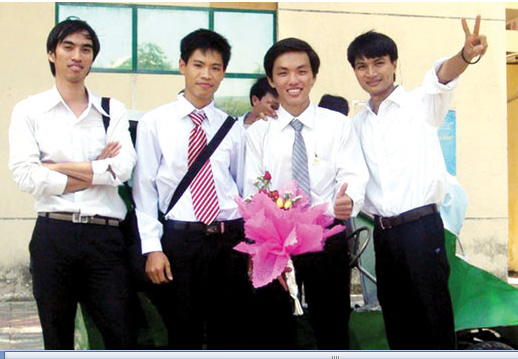Three students and the green car
Seeing the drops of perspiration rolling down the pedicab driver’s forehead, an idea flashed through the mind of the three students from the Da Nang University of Technology that it is necessary to force sunlight to serve the needs of human beings. As such, the clean car SC4 has been born.

“At first, we intended to manufacture a 3-wheel pedicab run by solar energy which allows drivers to save 70 percent of their strength,” Ta Ngoc Thien Binh, head of the SC4 car research team said. However, they later decided to manufacture a clean car, especially when they found out that the car prices in Vietnam are still incredibly high.
Also according to Thien Binh, solar-energy run cars have the common disadvantage that they always need a long time to recharge their batteries, while the capability of running continuously and the operation scope remain limited.
The group of three students Ta Ngoc Thien Binh, Huynh Kim Trang and Pham Nguyen Son then decided to design a transmission using the technology of converting petrol-run engines into gas-run engines (LPG, NGV, or biogas). The technology was invented by Professor Dr Bui Van Ga. When the supply of electricity runs out or there is no sunlight, SC4 will run by a heat engine, using LPG, which is installed together with the electricity engine.
Son related that after three months, SC4, the pet of the three students, was born and successfully tested. The car can carry two people (each person weights 70 kilograms) and can achieve speeds up to 50 kilometers/hr. The car can run continuously when there is sunlight, while the “life expectancy” of the car is about 20 years. The total production cost of the car, including mechanical engineering and designing expenses, would be about 60 million dong.
“The car proves to be suitable for use in tourist cities like Da Nang, Hoi An and Ha Long, because they can bring people to do shopping. If compared to petrol run cars, the SC4 is notably inferior in its functions, but SC4 has its own advantages. It can charge electronics such as laptop or mobile phones,” Son said. “Besides, it does not require special care and regular maintenance”.
Accepting risks and the dream of becoming “the boss”
The head of the SC4 team related that at first the team had four members. However, when the idea about a clean car was discussed, many people had doubts about its feasibility. Therefore, a member left the team.
However, the other three other members decided to continue to manufacture a clean car. They decided to look for relating documents everywhere, including going to HCM City. They spent all the money they had and all the money they borrowed to manufacture an experimental model which had production cost of 13 million dong.
The students shared that they were lucky enough to receive the support from Duong Viet Dung, a teacher, and from their faculty which gave them a room that was used as a “mechanical workshop”.
From all of their efforts and support they have achieved success. The scientific research work off the three students was awarded the first prize in the competition of students doing scientific research. Binh said that the car has a very special significance, because it not only has brought the first prize, but new knowledge and experience useful for his life. Before getting a scholarship due to his scientific research, Binh had received a scholarship to study two years at Ulsan University in South Korea.
Discussing the future, Binh said that he will spend his time to perfect the SC4. “I will to become the boss of a made-in-Vietnam car manufacturing company when I return after the university study,” he said.
VietNamNet Bridge

